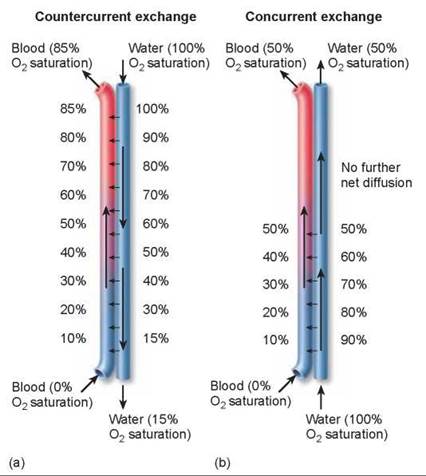THE LIVING WORLD
Unit Six. Animal Life
24.2. Respiration in Aquatic Vertebrates
Have you ever seen the face of a swimming fish up close? A swimming fish continuously opens and closes its mouth, pushing water through the mouth cavity and out a slit at the rear of the mouth—and (this is the whole point) past the gills on its one-way journey.
This swallowing process, which seems so awkward, is at the heart of a great advance in gill design achieved by the fishes. What is important about the swallowing is that it causes the water to always move past the fish’s gills in one and always the same direction. Moving the water past the gills in the same direction permits countercurrent flow, which is a supremely efficient way of extracting oxygen. Here is how it works:
Each gill is composed of two rows of gill filaments (two sections of gills are shown in the middle panel in figure 24.1, each with two rows of gill filaments). The gill filaments are made of thin membranous plates stacked one on top of the other and projecting out into the flow of water. As water flows past the filaments from front to back (indicated by the blue arrows in the enlargements), oxygen diffuses from the water into blood circulating within the gill filament. Within each filament the blood circulation is arranged so that the blood is carried in the direction opposite the movement of the water, from the back of the filament to the front. The advantage of the countercurrent flow system is that blood in the blood vessels of the gill filaments always encounters water that has a higher oxygen concentration, resulting in the diffusion of oxygen into the blood vessels. To understand this, compare the countercurrent exchange system in figure 24.2a to a concurrent exchange system in figure 24.2b. In the countercurrent system, when blood and water flow in opposite directions, the initial oxygen concentration difference at the bottom is not large (10% in the blood and 15% in water), but it is sufficient for oxygen diffusion. As the blood oxygen concentration increases as it travels upward, the blood continually encounters water with a higher oxygen concentration. Even at 85% oxygen concentration in the blood, it is still encountering oxygen concentrations in water of 100%. In the concurrent exchange system, oxygen diffusion is rapid at first, because of the large difference in oxygen concentrations between the blood and water (0% versus 100%), but quickly slows as the difference becomes less until it reaches equilibrium at 50% saturation. Thus, countercurrent flow ensures that an oxygen concentration gradient remains between blood and water throughout the flow, permitting oxygen diffusion along the entire length of the filament.

Figure 24.1. Structure of a fish gill.
Water passes from the gill arch over the filaments (from left to right in the diagram). Water always passes the lamellae in the same direction, which is opposite to the direction the blood circulates across the lamellae.

Figure 24.2. Countercurrent flow.
Because of the countercurrent flow, the blood in the fish’s gills can build up oxygen concentrations as high as those of the water entering the gills. The gills of bony fishes are the most efficient respiratory machines that have ever evolved among organisms.
Key Learning Outcome 24.2. Fish gills achieve countercurrent flow, making them very efficient at extracting oxygen.